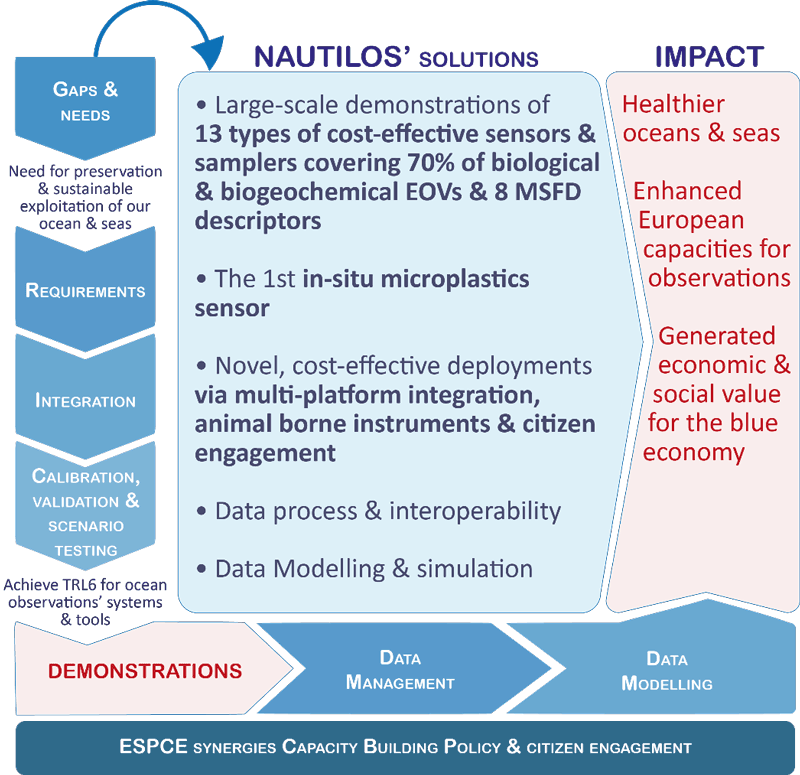by Gabriele Pieri (ISTI-CNR)
The NAUTILOS project aims to fill some of the existing gaps in marine observation and modelling by improving the measurement of chemical, biological and deep ocean physics variables. A new generation of cost-effective sensors and samplers is being developed, integrated into observation platforms and deployed in large-scale demonstrations off the coastline of Europe. These will complement and expand existing observation tools and services, allowing researchers to obtain data at a much higher spatial resolution, temporal regularity and length than is currently available at a European scale. It will also facilitate and democratise the monitoring of the marine environment for both traditional and non-traditional data users.
Environmental observational research in coastal and shelf sea environments, which are characterised by substantial dynamic variability [1], has its own specific challenges. Dense observation efforts in time and space are required to assess biological, chemical and physical processes that are very patchy in nature, such as mesoscale features. Typically, the processes are also highly variable in time due to short-term environmental forcings like upwelling and mixing events that may result in potentially harmful algal blooms. We need a high level of spatial resolution and both high temporal resolution and length (i.e. time-series) to accurately quantify variables such as temperature, momentum, biological and biogeochemical fluxes, how they are changing, and what processes are forcing these changes. High quality data can help us manage and mitigate events that might have adverse climatic, environmental and economic outcomes.
The NAUTILOS project focuses on both the deep ocean at depths of greater than 200 m, and the open ocean environment above it. These are the least observed but largest habitats on our planet (see Figure 1). Future deep ocean observing needs greater integration across disciplines and sectors, best achieved through demonstration projects and facilitated reuse and repurposing of existing deep-sea data efforts [2].
The next step in the evolution of the marine monitoring system will be the widespread adoption of autonomous in situ sensing. There is a need to explore and test new technology that will make it more affordable to acquire, deploy and maintain monitoring and observing stations to fill the in situ observational gaps of ocean observation systems. With increased spatial resolution and frequency of in situ collection and a greater volume of information coming from cost-effective and more widely disseminated sensors, many new operational products will become available. With these will come new forecasting capabilities and processes for understanding the ocean. The improvement and effectiveness provided by this new "digital ocean" observation paradigm based on big data can be statistically evaluated using oceanographic models of different data availability scenarios and evaluating the improvement of forecasting capabilities. These scenarios would reflect the potential increase in spatial resolution, time frame and gap closure of the acquired data anticipated by this project. Technology maturation will promote the “democratisation” of marine environmental monitoring through the production of small, cost-effective sensors.
Such a realisation will broaden the range of users who will benefit from the increase in data and forecasting models. It will enable both traditional users, such as oceanographers, researchers and technology providers, and others, such as citizen scientists, resource managers, policymakers and environmental monitoring groups, to access new and improved resources. The full adoption of the technologies developed and demonstrated in project NAUTILOS can only increase participation in environmental observation, help reduce the costs of the technology, and thus multiply the social, economic and environmental benefits and positive impact of the project.

Figure 1: The NAUTILOS Project concept.
The NAUTILOS project, funded by the EU under the call H2020-BG-2020-1, is an Innovation Action Pilot that is just starting its activities, which are foreseen to last for four years. The consortium, composed of 21 partners from 11 countries from across Europe, is coordinated by the National Research Council of Italy (participating with three different institutes), has a wide, complementary and multidisciplinary expertise in various fields ranging from oceanography to biology and biogeochemistry, as well as from data processing and modelling to marine technological applications and research infrastructures. Apart from the coordinator , the involved partners are: the “Hellenic Centre for Marine Research”, the “Norsk Institutt for Vannforskning”, the “Suomen Ymparistokeskus”, the “Institut Francais de Recherche pour l'Exploitation de la Mer”, the “Centre National de la Recherche Scientifique”, “ETT S.p.A.”, “EdgeLab S.r.l.”, the “Universidade do Algarve”, “NKE Instrumentation S.a.r.l.”, “Aquatec Group limited”, “SubCTech GMBH”, the “Centro de Engenharia e Desenvolvimento”, the “Haute Ecole Specialisee de Suisse Occidentale”, the “Centre Suisse d'Electronique et de Microtechnique SA”, the “University of Lubljana”, “Fudaçao EurOcean”, the “Deutsches Forschungszentrum fur Kunstliche Intelligenz GMBH”, the “University of Calabria”, the “Instituto do Mar”, and “EvroProject OOD”.
References:
[1] K. H. Wiltshire et al.: “Resilience of North Sea phytoplankton spring bloom dynamics: An analysis of long‐term data at Helgoland Roads”, Limnology and Oceanography, 53(4), 1294-1302, 2008.
[2] L. A. Levin et al.: “Global observing needs in the deep ocean” Frontiers in Marine Science, 6, 241, 2019.
Please contact:
Gabriele Pieri, ISTI-CNR, Italy











